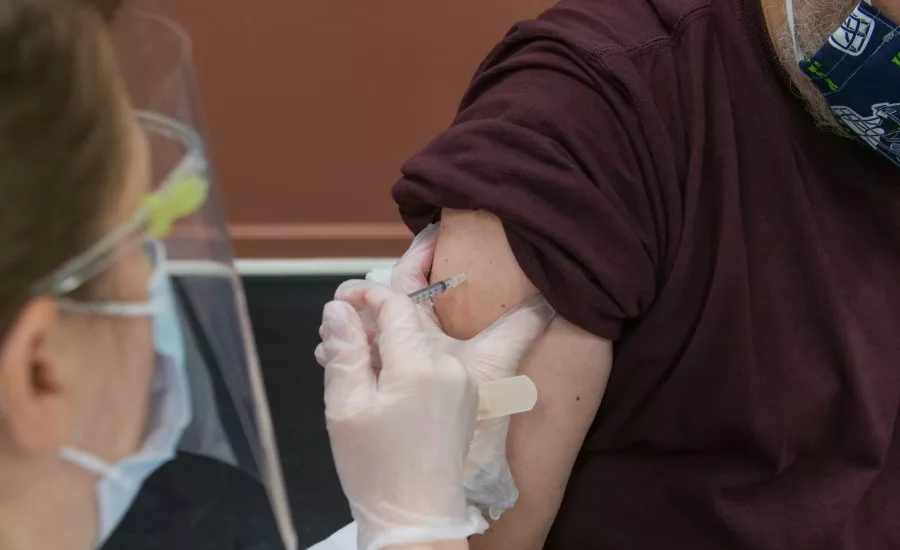CDC Updates COVID-19 Guidelines for Construction Industry, Vaccinated Individuals
Fully Vaccinated Individuals Can Resume Certain Activities Safely

Photo by Steven Cornfield on Unsplash.
With more people being vaccinated against COVID-19, it seems there may be light at the end of the tunnel, but guidelines from the Centers for Disease Control (CDC) indicate we’re not there yet.
On Monday, the CDC released its first set of recommendations on activities people can safely partake in if they are fully vaccinated against COVID-19. This is coupled with a recent addition to its construction industry COVID checklist that encourages employers to take note of their worker's mental health as the pandemic continues.
Based on the latest science, the recommendations list how and when a fully vaccinated person can visit with other people who are vaccinated as well as those who aren’t.
“We know that people want to get vaccinated so they can get back to doing the things they enjoy with the people they love,” said CDC Director Rochelle P. Walensky in a written statement. “There are some activities that fully vaccinated people can begin to resume now in their own homes.”
Fully vaccinated individuals can do the following:
- Visit with other fully vaccinated people indoors without wearing masks or staying 6 feet apart.
- Visit with unvaccinated people from one other household indoors without wearing masks or staying 6 feet apart if everyone in the other household is at low risk for severe disease.
- Refrain from quarantine and testing if they do not have symptoms of COVID-19 after contact with someone who has COVID-19.
A person is considered fully vaccinated two weeks after receiving the last required dose of vaccine. As of March 8, the CDC estimates only 9.2% of the U.S. population has been fully vaccinated. A recent survey shows that 53% of construction industry workers would receive a vaccine if offered to them, meaning progress for the roofing industry to resume normal activities may be slow-going.
It’s recommended that even those who are vaccinated continue practicing COVID-19 precautions when in public or visiting unvaccinated people from multiple households, including wearing masks and remaining at least 6 feet apart.
“Everyone — even those who are vaccinated — should continue with all mitigation strategies when in public settings,” said Walensky.
As previously reported, roofing contractors can require vaccinations as a condition of employment, but it is recommended that contactors consider a voluntary program instead, as there are difficulties with a mandatory program. During a live presentation held at the International Roofing Expo’s Virtual Edition about COVID in the workplace, a poll of attendees showed that 47% will create a voluntary vaccination program, while only 7% will require vaccines. Another 27% said they’d take no action.
Regardless of whether it’s voluntary or mandatory, it’s recommended that any workplace vaccination plan be staggered, as employees may experience temporary side effects that require additional time off.
Mental Health Awareness
As important as it is to stay physically healthy, the CDC recognizes the pandemic is having an effect on mental health, especially in the construction industry.
Although roofing being designated as essential means roofers can still work, they’re still dealing with stress from the virus, including an economic recession and supply shortages. Paired with the fact that roofing is already a dangerous occupation, the strain is bound to take a toll on workers.
The CDC has updated its COVID-19 checklist to include mental health. It recommends that employers talk openly with their workers about how the pandemic is affecting work, and to keep an eye out for behavior changes in workers.
“Anticipate behavior changes in your employees,” the checklist states. “Watch for changes like increased irritation or anger, increased worry or sadness, unhealthy eating or sleeping habits, and difficulty concentrating. These may be signs that your employee is struggling with stress or anxiety.”
The CDC notes common work-related factors that can add stress during a pandemic include:
- Concerns of being exposed to the virus
- Taking care of personal and family needs while at work
- Managing new or different workloads
- Lack of access to the tools needed to complete a job
- Feelings of not contributing enough to work, or guilt about not being "on the frontline"
- Uncertainty about the company’s future or employment
- Learning new tools or technology
- Adapting to different workspace or schedules
For more information, visit the CDC website.
Looking for a reprint of this article?
From high-res PDFs to custom plaques, order your copy today!








